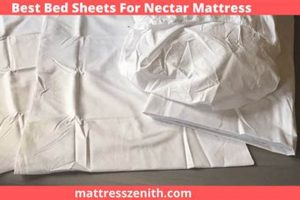A sleeping surface designed to provide optimal support and comfort for individuals with higher body weight is paramount for restorative rest. These mattresses typically incorporate enhanced construction and materials to address the specific needs of this demographic. For example, models with reinforced coils or high-density foam layers contribute to improved spinal alignment and reduced pressure points.
The selection of an appropriate sleeping surface for this population can significantly impact sleep quality, alleviate back pain, and promote overall well-being. Historically, standard mattresses often lacked the necessary support and durability for heavier individuals, leading to discomfort and premature wear. However, advancements in mattress technology have resulted in specialized options that effectively address these challenges. The benefits extend beyond immediate comfort, encompassing long-term spinal health and reduced risk of musculoskeletal issues.
Understanding the key features and considerations for such mattresses is essential. The following sections will explore specific mattress types, material compositions, and construction techniques relevant to ensuring optimal support and longevity.
Guidance for Optimal Mattress Selection
Selecting the appropriate sleeping surface requires careful consideration of several factors to ensure adequate support, durability, and comfort. The following guidelines outline key aspects to evaluate during the mattress selection process.
Tip 1: Prioritize Coil Gauge: Mattresses with lower gauge coils, typically in the 12-14 range, offer increased support and resistance to compression. This is particularly important to prevent sagging and maintain spinal alignment.
Tip 2: Evaluate Foam Density: High-density foam layers, ideally 2.5 pounds per cubic foot or higher for polyurethane foam and 4 pounds per cubic foot or higher for memory foam, provide enhanced support and durability compared to lower-density options.
Tip 3: Consider Hybrid Constructions: Hybrid mattresses, combining innerspring coils with foam or latex layers, often provide a balanced approach, offering both support and pressure relief.
Tip 4: Examine Edge Support: Reinforced edges prevent excessive sinking along the perimeter of the mattress, maximizing the usable sleeping surface and facilitating ease of getting in and out of bed.
Tip 5: Assess Weight Capacity: Review the manufacturer’s specifications to determine the mattress’s weight capacity and ensure it aligns with the user’s weight.
Tip 6: Explore Latex Options: Latex mattresses, known for their durability and responsiveness, can provide excellent support and pressure relief for heavier individuals.
Tip 7: Research Certifications: Look for certifications such as CertiPUR-US, which indicates that the foam has been tested for harmful substances and meets certain emissions standards.
Implementing these guidelines can significantly improve the likelihood of selecting a mattress that provides lasting comfort, support, and spinal alignment.
The subsequent sections will delve into specific mattress types and their suitability for individuals with higher body weights, further aiding in the selection process.
1. Coil Gauge Strength
Coil gauge strength within a mattress construction is a critical determinant of its suitability for individuals with higher body weights. The gauge, measured numerically, indicates the thickness of the steel wire used to create the coils; a lower gauge number signifies a thicker, stronger coil.
- Support and Resistance to Compression
Lower gauge coils provide superior support and exhibit greater resistance to compression compared to higher gauge alternatives. This is particularly relevant as heavier individuals exert increased pressure on the mattress surface, necessitating robust support to prevent sagging and maintain proper spinal alignment. Mattresses with insufficient coil gauge may deform prematurely, leading to discomfort and potential back pain.
- Durability and Longevity
The thickness of the coil directly impacts the lifespan of the mattress. Thicker coils are less prone to bending or breaking under sustained weight, contributing to increased durability and longevity. This is a significant consideration for individuals seeking a long-term investment in a supportive sleep surface. Mattresses lacking adequate coil strength often require more frequent replacement, resulting in increased expenses over time.
- Weight Distribution and Pressure Relief
Stronger coils contribute to more even weight distribution across the mattress surface. This uniform distribution minimizes pressure points, particularly in areas such as the hips and shoulders, which are prone to discomfort for heavier individuals. Proper weight distribution promotes healthy blood circulation and reduces the likelihood of tossing and turning during the night.
- Edge Support Enhancement
While coil gauge affects the overall support of the mattress, its influence extends to the edges as well. Mattresses with stronger perimeter coils provide enhanced edge support, preventing the “roll-off” sensation and maximizing the usable sleeping surface. This is particularly beneficial for individuals who tend to sleep near the edge of the bed or require assistance getting in and out of bed.
In summary, coil gauge strength is a pivotal factor in determining the effectiveness of a mattress designed for individuals with higher body weights. Its impact on support, durability, weight distribution, and edge support directly influences sleep quality and overall comfort. Selecting a mattress with appropriately low gauge coils is essential for ensuring a supportive and long-lasting sleep experience.
2. High-density foam support
High-density foam plays a crucial role in providing adequate support within mattresses designed for individuals requiring greater support. Its inherent properties contribute significantly to pressure relief, spinal alignment, and overall mattress longevity, making it a key determinant in selecting a suitable sleeping surface.
- Pressure Point Alleviation
High-density foam conforms closely to the body’s contours, distributing weight evenly and minimizing pressure concentration at key points such as the hips, shoulders, and knees. This alleviates discomfort and promotes improved circulation, reducing the likelihood of tossing and turning during sleep. Lower-density foams, conversely, may compress excessively, leading to localized pressure and discomfort.
- Spinal Alignment Maintenance
Maintaining proper spinal alignment is essential for preventing back pain and p
romoting overall musculoskeletal health. High-density foam provides consistent support across the mattress surface, preventing excessive sinking and ensuring the spine remains properly aligned throughout the night. This is particularly important for heavier individuals, who may experience increased spinal compression on less supportive surfaces. - Durability and Sag Resistance
The density of foam directly correlates with its durability and resistance to sagging over time. High-density foams exhibit greater resistance to compression and deformation, maintaining their structural integrity for longer periods. This is a critical consideration for individuals seeking a durable and long-lasting mattress, as sagging can lead to uneven support and discomfort.
- Motion Isolation Enhancement
High-density foam effectively absorbs and isolates motion, minimizing the transfer of movement across the mattress surface. This is particularly beneficial for couples, as it reduces the likelihood of disturbing a partner’s sleep due to tossing and turning. Lower-density foams offer less motion isolation, potentially leading to disrupted sleep.
The aforementioned facets collectively underscore the significance of high-density foam support in mattresses tailored for heavier individuals. By providing superior pressure relief, maintaining spinal alignment, ensuring durability, and enhancing motion isolation, high-density foam contributes significantly to a comfortable and restorative sleep experience. The selection of a mattress incorporating high-density foam is therefore a critical step in optimizing sleep quality and promoting long-term health.
3. Reinforced edge design
Reinforced edge design in a mattress directly impacts its suitability for individuals with higher body weights. The perimeter of a mattress is subjected to considerable stress, particularly during activities such as sitting on the edge or getting in and out of bed. Without adequate reinforcement, the edges can collapse or sag prematurely, reducing the usable sleeping surface and diminishing overall support. This is especially problematic for those who require maximum support across the entire mattress area. An example includes a mattress marketed without edge support that quickly develops a noticeable slope at the sides, leading to discomfort and an unstable sleeping experience.
The incorporation of reinforced edges, often achieved through the use of high-density foam encasements or specialized coil systems along the perimeter, mitigates these issues. This enhancement not only expands the available sleeping area but also provides a more stable and supportive surface for sitting or moving near the edge. Furthermore, it contributes to the overall longevity of the mattress by preventing the development of structural weaknesses that can lead to premature wear and tear. For instance, a mattress with edge support can facilitate easier transfers for individuals with mobility limitations, preventing falls and injuries. This design element directly addresses the challenges faced by individuals needing consistent support across the entire surface.
In summary, reinforced edge design represents a critical component in the construction of mattresses designed for individuals requiring enhanced support. It addresses the specific needs of this demographic by maximizing the usable sleeping surface, providing a stable perimeter, and contributing to overall mattress durability. The presence of robust edge support can significantly improve the sleep experience and enhance the long-term value of the investment. Conversely, its absence can lead to premature degradation of the mattress and reduced comfort and support.
4. Durable material composition
The concept of durable material composition is inextricably linked to the effectiveness of a sleeping surface for individuals with higher body weights. The increased stress and compression exerted on a mattress by a heavier person necessitate the use of materials that can withstand sustained pressure without degrading prematurely. The longevity and support provided are directly correlated with the inherent durability of the materials used in its construction. For example, lower-quality foams and coil systems will exhibit sagging and reduced support far more quickly than those constructed with high-density foams and tempered steel coils, directly impacting sleep quality and potentially exacerbating back pain. The selection of resilient materials is, therefore, not merely a matter of preference but a fundamental requirement for a mattress intended for heavier individuals.
Consider the practical implications of material selection. A mattress employing a high-density polyurethane foam core, reinforced with individually wrapped steel coils, demonstrates a clear understanding of material durability. The foam provides consistent support and resists compression over time, while the individually wrapped coils contour to the body’s shape, minimizing motion transfer and preventing the entire mattress from sagging in response to localized pressure. Conversely, a mattress utilizing a low-density memory foam layer over a poorly constructed innerspring system will likely exhibit significant sagging within a relatively short timeframe, leading to compromised spinal alignment and discomfort. The former example illustrates the benefits of a durable material composition, while the latter highlights the consequences of its absence.
In conclusion, the incorporation of durable materials is not an ancillary consideration but a core requirement for creating a sleeping surface suitable for heavier individuals. It ensures sustained support, promotes longevity, and contributes to overall sleep quality. Understanding the impact of material composition empowers informed purchasing decisions, ultimately leading to a more restful and supportive sleep experience. Challenges remain in balancing durability with comfort and cost, but prioritizing material quality is essential for long-term satisfaction.
5. Optimal weight capacity
The term “optimal weight capacity” represents a critical parameter in determining the suitability of a mattress, particularly when considering the needs of individuals with higher body weights. A mattress’s specified weight capacity directly dictates its ability to provide adequate support and maintain structural integrity over time. Exceeding this limit inevitably leads to accelerated wear and tear, resulting in sagging, reduced support, and a compromised sleep experience. For individuals requiring a supportive sleep surface, selecting a mattress with an appropriate weight capacity is not merely advisable, but essential for ensuring both comfort and long-term durability. An example of selecting a mattress with low weight capacity for a high weight will resulting in the product not performing and early wear and tear.
The relationship between “optimal weight capacity” and the provision of a suitable sleep surface is causative. A higher weight places increased stress on the mattress’s internal components, including the coils, foam layers, and support structure. If the mattress lacks the necessary weight capacity to withst
and this pressure, these components will deform and degrade more rapidly, leading to a loss of support and an uneven sleeping surface. For example, the failure to consider weight capacity may result in the formation of body impressions, particularly in the central area of the mattress, leading to discomfort and potential back pain. Properly chosen weight capacity is a protection and investment to product last longer.
Understanding the significance of “optimal weight capacity” allows for informed purchasing decisions, ensuring that the selected mattress meets the specific needs of the user. By carefully reviewing the manufacturer’s specifications and considering individual weight and sleep habits, it is possible to identify a mattress that will provide consistent support and maintain its structural integrity over an extended period. This proactive approach minimizes the risk of premature mattress failure and maximizes the return on investment, ultimately contributing to a more restful and supportive sleep experience. Although challenges may arise in comparing weight capacity specifications across different brands, the overarching principle remains: selecting a mattress with a weight capacity that exceeds the user’s weight is a critical step in ensuring long-term comfort and durability.
6. Targeted back support
Targeted back support constitutes a fundamental component in the selection of an appropriate mattress for individuals with higher body weights. The increased gravitational force exerted by a heavier person places greater strain on the spinal column and surrounding muscles, exacerbating pre-existing back conditions or predisposing them to new musculoskeletal issues. Consequently, a mattress that fails to provide adequate and specifically targeted support can lead to chronic back pain, reduced sleep quality, and diminished overall well-being. For example, a heavier individual sleeping on a mattress lacking targeted lumbar support may experience persistent lower back pain due to spinal misalignment and muscle strain. Conversely, a mattress designed with reinforced support in the lumbar region can alleviate these symptoms by promoting proper spinal alignment and reducing pressure on sensitive areas. The inclusion of targeted support features is, therefore, not a mere luxury but a necessity for mitigating the risks associated with increased weight and its impact on the spine.
The implementation of targeted back support can take various forms, including zoned coil systems, strategically placed foam inserts, and adjustable lumbar support features. Zoned coil systems utilize varying coil densities across the mattress surface, providing firmer support in areas requiring it most, such as the lumbar and sacral regions, while offering softer support in areas such as the shoulders and hips. Foam inserts, typically constructed from high-density memory foam or latex, can be strategically positioned to provide additional support in specific areas of the back, further enhancing spinal alignment. Adjustable lumbar support features, often found in air mattresses, allow individuals to customize the level of support to their individual needs, accommodating varying body types and spinal conditions. These diverse approaches underscore the recognition that effective back support is not a one-size-fits-all solution but rather a personalized requirement. For instance, a mattress with adjustable lumbar support would be beneficial for someone with scoliosis or other spinal abnormalities, allowing them to fine-tune the support to alleviate their specific pain points.
In conclusion, targeted back support is an indispensable element in the design of mattresses intended for individuals with higher body weights. Its inclusion addresses the heightened risk of back pain and spinal misalignment associated with increased gravitational forces, promoting improved sleep quality and overall musculoskeletal health. While the specific implementation of targeted support may vary depending on individual needs and preferences, the underlying principle remains constant: a mattress must provide adequate and strategically placed support to ensure proper spinal alignment and mitigate the risk of back-related discomfort. The challenges remain in selecting products for each individual needs. By prioritizing mattresses with these characteristics, consumers can make informed decisions that contribute to their long-term health and well-being.
7. Cooling technology integration
Cooling technology integration in a mattress directly impacts its suitability for individuals with higher body weights due to the correlation between body mass and heat retention. Increased body mass typically results in greater heat production and reduced surface area to volume ratio, leading to a propensity for overheating during sleep. The integration of cooling technologies within a mattress serves to mitigate this effect, promoting a more comfortable and restful sleep experience. A mattress lacking effective cooling features may exacerbate existing heat-related discomfort, leading to disrupted sleep patterns and increased tossing and turning. Without cooling technology, the best mattress for heavy person will not have its full potential.
Various cooling technologies are implemented in mattress design, including breathable materials, gel-infused foams, and phase-change materials. Breathable materials, such as open-cell foams and natural fibers, facilitate air circulation within the mattress, dissipating heat and moisture. Gel-infused foams incorporate gel particles that absorb and dissipate heat, providing a cooling sensation. Phase-change materials possess the ability to absorb or release heat as they transition between solid and liquid states, maintaining a consistent temperature. The effectiveness of these technologies depends on the specific materials used, the mattress construction, and the ambient temperature of the sleep environment. For instance, an individual residing in a humid climate may benefit from a mattress with enhanced moisture-wicking properties in addition to cooling features. Selecting mattress with consideration of cooling tech is essential for a better sleep.
In summary, cooling technology integration is a critical consideration when selecting a mattress for individuals with higher body weights. The propensity for increased heat retention necessitates the incorporation of features that promote temperature regulation and moisture dissipation. By prioritizing mattresses with effective cooling technologies, consumers can enhance their sleep comfort and mitigate the risks associated with overheating. The challenge lies in identifying the most appropriate cooling technology for individual needs and preferences, considering factors such as climate, body temperature, and sleep habits. Future advancements in material science and mattress design may further enhance the effectiveness of cooling technologies, contributing to improved sleep quality for all individuals.
Frequently Asked Questions
This section addresses common inquiries regarding mattresses specifically designed to provide optimal support and comfort for individuals with higher body weights. It aims to clarify key considerations and dispel misconceptions surrounding mattress selection for this demographic.
Question 1: What differentiates a mattress designed for a heavier person from a standard mattress?
Mattresses designed for heavier individuals typically incorporate
enhanced coil systems, higher density foam layers, and reinforced edge support to provide increased support and durability compared to standard mattresses. These features are essential for preventing sagging and maintaining proper spinal alignment.
Question 2: Is innerspring, memory foam, or latex the optimal mattress type?
Each mattress type offers unique benefits. Innerspring mattresses with low gauge coils provide robust support. Memory foam conforms to the body, alleviating pressure points. Latex offers a balance of support and responsiveness, along with enhanced durability. Hybrid mattresses, combining these materials, often provide the most comprehensive solution.
Question 3: How important is weight capacity when selecting a mattress?
Weight capacity is a critical factor. Exceeding the manufacturer’s specified weight limit can lead to premature wear and tear, reduced support, and an overall decline in mattress performance. Selecting a mattress with an adequate weight capacity is essential for ensuring long-term durability and comfort.
Question 4: What coil gauge is considered appropriate for enhanced support?
Lower gauge coils, typically in the range of 12-14, offer increased support and resistance to compression compared to higher gauge alternatives. These thicker coils are better equipped to withstand the sustained pressure exerted by heavier individuals, minimizing sagging and maintaining spinal alignment.
Question 5: Does mattress thickness correlate with improved support?
While mattress thickness can contribute to overall comfort, it is not the sole determinant of support. The density and quality of the materials used, as well as the construction of the support core, are equally important. A thicker mattress constructed with low-density materials may provide less support than a thinner mattress with high-density components.
Question 6: Are there specific certifications to look for when purchasing a mattress?
Certifications such as CertiPUR-US indicate that the foam used in the mattress has been tested for harmful substances and meets certain emissions standards. This certification provides assurance regarding the safety and quality of the materials used in the mattress construction.
In summary, the selection of a suitable mattress for individuals with higher body weights requires careful consideration of factors such as coil gauge, foam density, weight capacity, and construction materials. Prioritizing these aspects can significantly enhance sleep quality and promote long-term health.
The following section will provide a curated list of recommended mattresses based on the aforementioned criteria.
Conclusion
The preceding discussion has illuminated the multifaceted considerations essential when selecting the optimal sleeping surface for individuals with higher body weights. Factors such as coil gauge strength, high-density foam support, reinforced edge design, durable material composition, appropriate weight capacity, targeted back support, and cooling technology integration have been presented as crucial determinants of mattress performance and longevity.
The selection of the best mattress for heavy person requires a thorough assessment of individual needs and preferences, coupled with a critical evaluation of available product features. Prioritizing these considerations will lead to improved sleep quality, enhanced spinal health, and a more sustained investment in a supportive sleep environment. Continued advancements in materials science and mattress technology promise to further refine the options available to this demographic, underscoring the importance of ongoing research and informed consumerism.




![Top-Rated Best Fold Out Mattress [Guide & Reviews] Organic & Natural Mattress Buyer’s Guide: Non-Toxic Sleep Solutions Top-Rated Best Fold Out Mattress [Guide & Reviews] | Organic & Natural Mattress Buyer’s Guide: Non-Toxic Sleep Solutions](https://mattressworldpa.com/wp-content/uploads/2025/07/th-7689-300x200.jpg)


